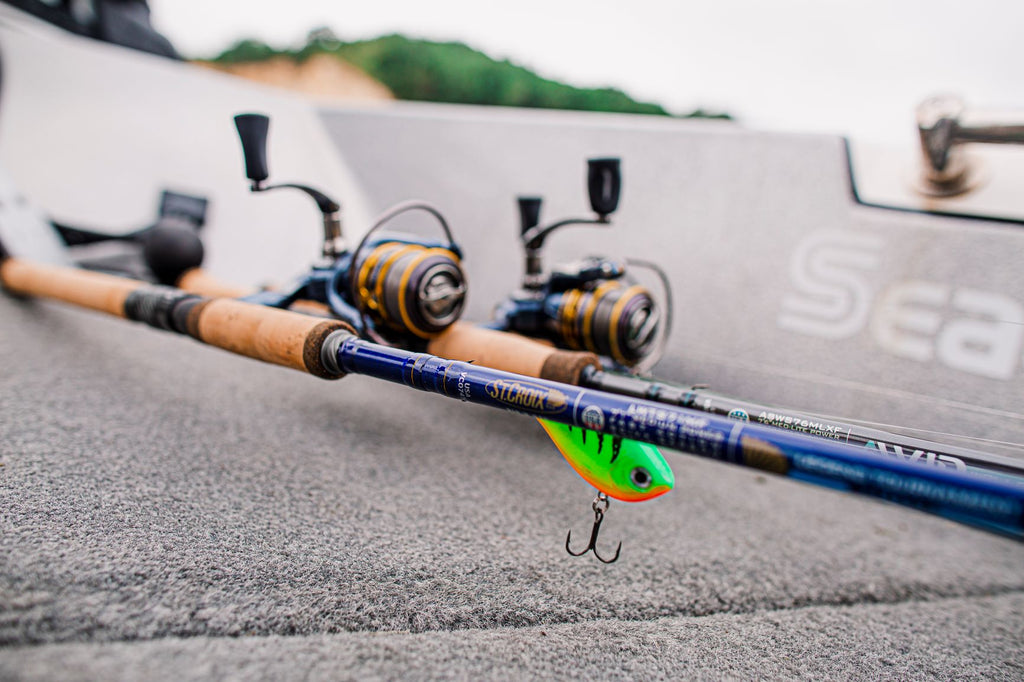Post
Spawn Walleye Strategies
May 18, 2023

Walleyes disperse after their spring spawning runs but still remain somewhat concentrated in fairly predictable locations. That’s good news for walleye anglers who know where to look. Once found, hungry post-spawn walleyes are unlikely to turn down a meal, further sweetening the deal for late-spring and early-summer anglers.
Chuck Mason of Ida, Michigan chases walleyes all year long. An ice and open-water tournament angler for nearly 20 years, Mason can be found on his home waters of the Detroit River, Lake St. Clair, and Western Lake Erie when not traveling on the Michigan Walleye Tour.

“You can catch walleyes in the Detroit River year ‘round,” Mason says. “Even though spawning is wrapped up, certainly May and even into early June you can still get on concentrations of fish in the river, but I like to follow the fish back down to Lake Erie during this period. There are a few areas where dredging spoils create a lot of humps and variability in depth that really seem to concentrate our post-spawn walleyes. One is an area known as ‘the humps’ off the river near Monroe, Michigan, and another known as ‘the dumping grounds’ out of Luna Pier.”
Mason typically employs four primary presentations for post-spawn walleyes, namely, casting hair jigs, pitching lipless crankbaits and Jigging Raps, vertical jigging, and trolling. “Depending on timing and water temperatures, you may want to be in one place over the other. “We start out snap-jigging hair jigs and ripping lipless baits on the Detroit river, then shift more to using blade baits further down out of the mouth on Lake Erie,” says Mason.
Hair Jigs

“There’s so many ups and downs in the bottom in these areas… just so many places for walleyes to hide,” says Mason, who makes his own custom hair jigs. “I’m usually targeting fish in 16-20 feet of water at this time of year in these spoils areas, so you need a heavier jig. I’ll start at a half-ounce and go as heavy as an ounce and a quarter if necessary.”
Mason makes two styles of hair jigs using jig heads he creates using Do-It molds. “I use their standard ‘Walleye Jig’ head for hair jigs I tie for vertical jigging, and their ‘Ultra Minnow’ head for hair jigs I’ll use for pitching and casting.” He prefers variations of white for stained-water conditions and variations of purple for clear or very dirty water.
“When pitching or casting hair jigs, I’m basically just popping the thing 6” off the bottom, letting it fall. Then popping it again,” says Mason, who prefers to fish his hair jigs on a 6’8” medium power, extra-fast action St. Croix Legend Tournament Walleye (LWTS68MXF) spinning rod. He completes his hair jig rig with a 2500-size spinning reel spooled with Suffix 832 hi-vis 10-pound braid connected to a short 10-pound fluorocarbon leader. “There’s a bunch of great hair-jig rods in St. Croix’s Legend Tournament Walleye Series,” Mason adds. “A lot of anglers go to a medium-light power extra-fast rod like the 7’3” MLXF or even the 7’6” MLXF for hair jigs – both awesome rods – but I’m not casting as far and fishing deeper than most, so I really need the extra power of an MXF. The hi-vis line helps me keep the proper angle so I know where my jig is in relation to the boat. The no-stretch braided line and the rod’s extra-fast action gives me plenty of sensitivity and hook-setting power.” Mason says the hair-jig bite in his area usually ends in early June.
Lipless Cranks & Jigging Raps

Mason says Rippin’ Raps, other lipless crankbaits, and Jigging Raps are also excellent post-spawn walleye producers. “We fish them right up to early June,” he says. “The mouth of the Saginaw River is nice and wide. We work these baits along the channel edges and there’s an especially nice drop off along the west side.”
Mason says how these baits are presented – upslope or downslope – is a wind-driven decision. “In most cases I’ll position the boat up on the flat, cast over the break into the deep water and work it back up the hill,” says Mason, adding that he’ll reverse the pattern – cast shallow and work the bait downhill – if the wind is out of the east.

“I use the same reels and line set up as I do for the hair jigs,” says Mason, who presents Lipless cranks on the Legend Tournament Walleye 7’1” medium power, fast action RIP-N-RAP model, and Jigging Raps on the 7’1” medium power, moderate-fast action JIG-N-RAP rod. “These rods are remarkably similar, featuring an extended foregrip and great balance that helps minimize the wrist and arm fatigue that usually plagues this style of fishing. The slightly softer JIG-N-RAP rod is a bit more parabolic because Jigging Raps tend to have smaller hooks.”

Mason says the fish determines whether he’ll fish Jigging Rap or Rippin’ Rap. “I usually prefer a Jigging Rap in cleaner, shallower water and a Rippin’ Rap – which has a rattle and a larger profile – in darker or deeper water,” Mason says. The Rippin Rap gets the nod in warmer water, too. “I’ll be a lot less aggressive in cold water… like a 2’ lift and fall on a tight line. Once the water gets over 50 degrees you really can’t be too aggressive. You can really start ripping like 2-4’ off the bottom and speed up your cadence.” Mason prefers variations of chrome/blue or chrome/purple, as well as the white/mossback, and Helsinki colors.
Vertical Jigging
Vertical jigging is a staple presentation for walleye anglers everywhere in a wide variety of conditions. It’s certainly a go-to on the deep, fast waters of the walleye-infested Detroit River where Mason spends ample hours. “You always want to fish as light a jig as you can get away with and still stay vertical,” Mason says. “If I can get away with 5/8-ounce jig on the Detroit River, I’ll do it, and I’ll out fish everyone else using a ¾-ounce or 1-ounce jig,” he adds. “Some days and in many locations – like when fish are stacked in 50’ of water under the Ambassador Bridge – you’re going to need a one-ounce or even an ounce-and-a-quarter jig to keep it in their faces.”
For such heavyweight jigs, Mason – like so many other big-river walleye anglers – fell in love with the HEAVY METAL rod (EYS58HF) introduced to St. Croix’s popular Eyecon walleye series a couple of years ago. “I just fell in love with that rod,” he says. “It has great balance and feel and there’s nothing else like it for fishing deep and heavy. But as good as that rod is, now walleye anglers can get the HEAVY METAL rod in the new Legend Tournament Walleye lineup (LWTS58HF). It’s just so incredibly light and crisp for a heavy-power rod.” Mason uses the same 2500-size spinning reel and 10-pound braid and fluoro setup when vertically fishing deep with heavy jigs. “Also, in the Trenton Channel – where the big girls are many and it’s a complete jig graveyard – the LTW HEAVY METAL allows for intense control, driving home hooks through hard mouths quickly, while providing a fast response that makes it the right tool for the job. It just feels so light in your hand, which is key for fishing all day, pumping heavy jigs in fast current,” Mason adds.

Mason often bulks up his heavy jig offerings on the Detroit River. “We fish our vertical jigs with Wyandotte Worms and plastic minnows, then tip them with live bait rigged with a stinger hook,” he says. What sounds like a clunky offering has some real method behind its apparent madness. “Tipping the presentation does two things,” Mason advises. “It bulks up the profile in dirty water while also adding flavor and scent.”
Up on the Saginaw River – another of Mason’s Michigan walleye hotspots – he says he can get away with a bit lighter jig. “5/8-ounce is normally the heaviest I’ll go in there,” he says, “but usually a 3/8 or even a ¼-ounce when I’m fishing a plastic grub or a paddletail. The smaller jigs are my finesse presentation in clean, shallow water or in areas that are completely out of the current.” In these cases, Mason switches to the 6’3” medium power, extra-fast action VERTICAL JIG rod in the Legend Tournament Walleye lineup (LWTS63MXF). “That rod will actually handle a 1-ounce jig surprisingly well, but it excels in that ¼ to ¾-ounce range.”

Slipping/Trolling
Pulling harnesses on bottom bouncers is another proven post-spawn presentation anywhere walleyes swim. “In the river, you’re just using your bow-mount to control the boat as it slips down current. About 1.3 MPH is usually the sweet spot… just slow enough where you can get the blades on the harnesses to spin,” advises Mason, who forgoes rod holders and prefers to keep a rod in each hand when employing this technique. “I use the 7’ Legend Tournament Walleye BOUNCE-N-TROLL rods (LWTC70MHM) with CT100 reels so I can palm the reels,” he says. “I don’t need a line-counter reel because I can feel the bottom.” I start pulling harnesses when the water gets above 50 degrees.

Mason typically uses a 3-ounce bottom bouncer and a short 26” to 36” harness, usually tipped with half a crawler. He connects his 15-pound Suffix hi-vis braid to the bouncer with a #2 snap. “The way I fish harnesses is all by feel,” Mason says. I like one rig right on the bottom and the other one a couple feet up. I give both rods slow, short lifts and falls. The colder the water the slower the motions. You can get more aggressive when the water warms up. I think that higher rod actually attracts fish in to investigate and I’ll fish it even higher off the bottom when the water is clear. Giving the fish two options makes sense. They’ll tell you what they want then you can easily adjust the other rod to match.”
One trick Mason employs in his two-handed harness technique is to fish a left-side retrieve casting reel on the rod he holds in his right hand. “It saves precious seconds when a fish strikes,” he says. “You can just drop the other rod, lift, and start reeling without having to switch hands.”
There are plenty of ways to get bit during the post-spawn period, but careful matching of componentry and rigging for each presentation is key, and having the right rods is paramount to success. Vertical operations require a shorter, stouter rod to stand up to heavy jigs, while affording fast, effective hooksets. Pros that favor pitching jigs look to longer options in the 6’8” range for precision, all the way up to 7’6” when distance is identified as a critical factor. Diverse St. Croix rod families like Legend Tournament Walleye, Eyecon, and the all-new Avid Walleye Series, are widely employed for all walleye bites across the Midwest. No matter what series you choose, you’ll find quality rod choices specifically designed to give you the upper hand when targeting post-spawn walleyes with any technique or presentation.

